Kevin Plawecki

Going into the 2016 season, there was only thing missing from the roster – a backup first baseman.
However, fans were told to rest assured because there was a solution on their roster. The Mets were going to teach the position to Wilmer Flores. They were going to give a first baseman’s glove to their two catchers, Travis d’Arnaud and Kevin Plawecki. This would not only allow the team to have additional options at first, but it would also allow them to find more at bats for their two young catchers over the course of a season. Opening Day is a little over a week away. Guess how many combined games these three players have played at first base this Spring?
One.
Just one. Flores finally played a game there, and he described the experience as “weird.” He was only there because Lucas Duda couldn’t play yesterday. It’s probable Flores will get one other game there. The chances the catchers will get a game there now are slim to none. It’s just one giant wasted opportunity.
Sure, the Mets had Flores workout with Keith Hernandez at first base this Spring. In that sense, the Mets didn’t waste the time they had this Spring. However, there is just no substitute for game experience. Worst yet, they just wasted opportunities to get Flores game action at first. Marc Krauss, who shouldn’t play one game with the 2016 Mets, has played 15 games this Spring.
With so much on Flores’ plate this Spring, this was bound to happen. He had to prepare to become the main backup at each and every infield position. He had to work to become a better, more patient hitter at the plate. With David Wright‘s back, he has to be as ready as possible to play third. With Asdrubal Cabrera‘s injury coupled with Ruben Tejada‘s release, Flores had to spend time being sure he was ready to play shortstop. First base just fell by the wayside.
This all means one of three things:
- Duda is going to play 162 games;
- The Mets are comfortable with Flores at first regardless of his lack of game time there; or
- Eric Campbell is going to make the Opening Day roster.
Each passing day, it appears more and more likely that Campbell will be on the Opening Day roster. He’s played 17 games this Spring. Unlike Flores, he has played multiple games at first. Despite fans’ opinion of him, the Mets organization is bullish on Campbell’s abilities as a versatile bench player.
So, it’s most likely that the Mets have always seen Campbell as the backup first baseman. It would be the most plausible explanation why the Mets failed to expose Flores to first base for the vast majority of Spring Training. Conversely, if Campbell isn’t going to make the roster, the Mets have wasted Spring Training with respect to their inability to give Flores game action at first.
The most likely result is Eric Campbell making the Opening Day roster.
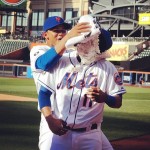
In honor of Pi Day, let’s look at all the things to look forward to during the 2016 season:
3.1 – Mike Piazza
This summer Mike Piazza is going into the Hall of Fame as a Met. He’s the first Mets position player to do so. The following weekend, he will also be the first Mets position player to have his number retired. He will forever be remembered for all of his homeruns, especially the homerun after 9/11. More importantly, he will forever be a Met.
41 – Tom Seaver
Seaver is the greatest Met to ever wear the uniform, and perhaps, the greatest right handed pitcher of all time. He was rightly dubbed “The Franchise.” With him, he began the aura of the Mets always having good pitching. This year his mantle will be picked up again by a dominant young staff reminiscent of the pitching staffs Seaver was a part of back in his day.
59 – Antonio Bastardo
Bastardo is one of a few key free agents the Mets added this offseason. Last year, the Mets had bullpen problems forcing them to overuse Jeurys Familia and trade a lot of good young pitching away to build a bullpen around the trade deadline. This year, Bastardo is a key arm in what appears to be a bullpen worthy of holding down the leads handed to them from their dominant starting pitchers.
26 – Kevin Plawecki
Plawecki had a rough 2015 whether it was because of him being rushed to the majors too soon or him needing sinus surgery. Given Travis d’Arnaud‘s injury history, it is very possible Plawecki is going to get another shot at being the Mets starting catcher next year. At some point, he will be called upon to not only continue his tremendous work as a receiver, but also being a more potent bat to the Mets lineup.
5 – David Wright
The biggest question mark in the 2015 season is how much David Wright can play and how effective he can be over the course of a 162 game season. Wright is the team leader and Captain, and they’re going to need him. At the end of 2015, he showed he can still hit and be an important part of the Mets. They’re going to need him at some point next year.
35 – Logan Verrett
After losing Verrett in the Rule 5 draft last year, he’s back with the Mets organization. Last year, he was an important swing man. He was first a bullpen arm and later a spot starter who gave a young pitching staff some rest before the postseason. In 2016, Verrett is likely to serve a similar role regardless of where he starts the year. At some point, the Mets will need him, even if it’s just to get the starters some rest before another postseason run.
89 – The Closing of a Window
After the Mets lost in the 1988 NLCS, there was no reason to believe that was the end of their window. There were veterans on the team, but there were also prospects behind them and rising stars on the team. There was still the pitching. It’s a stark reminder that when the window is open, you do everything you can in that timespan. You never know when that window closes.
79 – Paul Sewald
Sewald is just one of a number of Mets pitching prospects who are chomping at the bit to get called-up to the majors. Sewald has had a 1.83 ERA in his entire minor league career. If he continues pitching this well, he very well might get a call-up in the event there is an open bullpen spot this year.
32 – Steven Matz
In Matz’s first two career starts, he was incredible on the mound and at the plate. Even after his injuries, he has shown flashes of brilliance. He’s an early leader in the Rookie of the Year race. He’s primed to become the next great Mets starting pitcher. In 2016, he needs to stay healthy and take that next step.
38 – Dan Warthen
Warthen and the entire Mets organization have been blessed with amazing pitching. It’s encumbent upon Warthen to not only help each of these pitchers take the next step in their development, but also to help keep them healthy over the course of a full season.
4 – Wilmer Flores
We end with Flores, who was the last Mets to bat in the 2015 World Series. Flores was the player who cried at the possibility of leaving the Mets to a fan favorite. He has gone from the starting shortstop to a utility/platoon player. The 2016 Mets are a heavy left-hand hitting team. Flores can balance this out in his role as a super sub.
He’s also the first choice for third base in the event that Wright needs to sit or go on the DL for long stretches of time. He’s the primary backup at every infield position. He’s going to be an extremely important piece for the Mets.
They are all important actually. As we saw in 2015, a team will have to go deep into their roster at times. However, by building a strong 25 and 40 man roster, as the Mets have now, you give your team the best chance to make it to the postseason. Hopefully, the Mets can come full circle (pi pun) in 2016, and win the World Series.
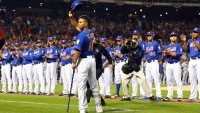
I’m sure Jedd Gyorko could be the answer to many questions. However, I’m fairly positive he’s not the answer to the question, “Who should be your starting shortstop?”
With the injury to Jhonny Peralta, Gyorko is the Cardinals starting shortstop. Unless the Cardinals make a move, Gyorko will be the shortstop for the next two to three months. Now, Gyorko was never anything more than an average second baseman which a career -1.5 UZR over his three year career. That doesn’t bode well for his chances to be a good to adequate shortstop. Like most, I’m assuming if any team can make it work, it’s the Cardinals.
With that said, it’s a good time for the Mets to call the Cardinals. From all the reports this Spring, it appears that the Mets might be looking to move on from Ruben Tejada. It’s probably the right move too.
Last year, Tejada had an impressive finish to the season. Although never mentioned as such, he was part of the reason why the Mets rallied to win the NL East. His gruesome injury in the NLDS was a rallying cry for the Mets and Mets fans throughout the postseason. However, he’s on the last year of his deal, and he’s an expensive backup eating up a spot on the 40 man roster.
The Mets right now have absurd depth at the shortstop position. Asdrubal Cabrera is penciled in as the starter the next two years. Wilmer Flores grew into the role and handled the position very well when pressed into shortstop duty again in the postseason. Former second round pick Matt Reynolds is competing for a utility role in the majors. On top of that, the Mets have two big shortstop prospects in Gavin Cecchini and Amed Rosario. Long story short, the Mets don’t need shortstop depth.
What they do need is 40 man roster space. So far, Jim Henderson is having a nice Spring and may be on the inside track to locking down a spot on the Opening Day bullpen. The Mets are talking about letting Kevin Plawecki start the year in AAA. This means, as of right now, Johnny Monell would open the year as the backup catcher. There’s a problem with Henderson and Monell making the Opening Day roster.
Neither player is on the 40 man roster, and the Mets have no spots open. Even if the Mets placed Zack Wheeler on the 60 day DL, the Mets would still need to drop someone else from the 40 man roster to add both Henderson and Monell. This could be accomplished by trading Tejada.
It seemed like Tejada turned a corner last year. Unfortunately, with one dirty play he is back on the bench, and frankly, occupying a roster spot the Mets need. It may not seem fair. It may seem cruel, but it’s time for the Mets too move on from Tejada. They should do it now with the Cardinals having a need, and the Mets wanting to maximize the return they would receive for Tejada.
Editor’s Note: this article also appeared on metsmerizedonline.com
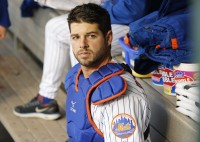
Finally, some common sense. The Mets are now talking about making Johnny Monell the back-up catcher on the Opening Day roster instead of Kevin Plawecki.
Truth be told, Plawecki is the better player right now between him and Monell. However, he’s also still considered a prospect that is going to need to receive regular at bats to get better. Remember Plawecki was a player the Mets believed could’ve challenged Travis d’Arnaud for the starting catcher spot last year. After 2015, it was clear Plawecki has more work to do offensively.
Plawecki was pressed into action when d’Arnaud got injured twice last year. In 73 games, Plawecki hit an ugly .219/.280/.296 with a 3 homeruns and 21 RBI. His OPS+ was a putrid 69, and his 60 wRC+ was just as bad. Yes, the Mets lineup at the time was historically bad, but his numbers show he was a big reason why. Simply put, Plawecki showed he was not ready for big league pitching.
Not to pile on him, but his AAA numbers suggests he shouldn’t have been called up in the first place. In 65 game in Las Vegas, Plawecki only hit .262/.318/.392. These numbers are even more troubling when you consider Cashman Field is a hitter’s park, and the Pacific Coast League is a hitter’s league. However, that’s not reason for concern. It’s reason to believe he just needs more time.
Up until his promotion to AAA in 2014, Plawecki raked. In 58 AA games, Plawecki hit .326/.378/.487 with six homers and 43 RBI. At that point, the Mets got aggressive with him and sent him to AAA where he hit .283/.345/.421 with five homers and 21 RBI in 43 games. It was 2015 when he rwall started to struggle. In the 22 games he played before getting called up to hold the fort for d’Arnaud, he was hitting .224/.267/.341. His hitting woes continued in the majors.
At this point, it should be noted that Plawecki did undergo sinus surgery in the offseason in the hopes it would cure the dizzy spells he experienced during the 2015 season. His dizzy spells could reasonably explain the precipitous drop off in his numbers. It may not. We will see in 2016.
Getting back to the 2016 season, the Mets have an option to make at backup catcher. d’Arnaud is the clear-cut starter. If healthy, he should be an All Star. If healthy, he needs to play as much as reasonably possible. For a catcher, that typically means you get days off in the following situations: (1) day game after a night game; (2) second game of a doubleheader; or (3) game after you caught a long extra inning game. There are other reasons, but those are typically the main ones. With that in mind, absent injury, your starting catcher will typical catch around 130 games.
In a 162 game season, that only leaves Plawecki with 32 games to play. For a player coming off a lost years, that will not help his development. He needs to play and see pitching. He needs to hit. If d’Arnaud gets hurt (again), Plawecki could come up from AAA and start in d’Arnaud’s spot. If Plawecki is then needed he will have been playing everyday, and he will hopefully in a nice groove instead of rotting away on the bench.
Let someone like Monell, who is getting no better, play those 32 games. Monell can hit terribly for those games. He can also prevent Plawecki from accruing service time.
Now, Plawecki is no longer a rookie due to the time he played in the majors last year. He’s also not arbitration eligible. Each day Plawecki is in the majors is another day, he’s closer to arbitration. It’s also another day the Mets lose team control of him. If you’re losing team control of him because he’s actually playing that’s understandable. However, losing control of him so he can play 30-40 games a year as a backup catcher makes no sense. It’s a mismanagement of team assets.
Keeping in the minors permits Plawecki to get the at bats he needs to improve. It also permits the Mets to keep team control. This helps Plawecki, and it helps the Mets. It permits the Mets to have more control for more years if they ever move on from d’Arnaud. It also makes Plawecki a more attractive trade option in the future. His value goes up if a team has more years of control.
In sum, Plawecki being the backup catcher helps no one. It doesn’t help him get better. It also doesn’t help the Mets maximize his value. Monell should be the backup catcher in 2016.
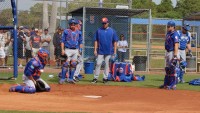
I don’t care what is happening. The Mets could be coming off a World Series appearance. The Mets could have traded everyone away in Marlins fashion. It doesn’t matter. It’s always good to see Mike Piazza with the Mets.
He’s back as a special instructor. He is there to work with Travis d’Arnaud and Kevin Plawecki. It makes sense to have a Hall of Fame catcher work with a budding All Star and prospect. Terry Collins intends gave Piazza more latitude than just working with the catchers. For example, Piazza took the time and the initiative to talk with Yoenis Cespedes about being a superstar in New York.
With his appearance at Spring Training, it did get me thinking about when and if Piazza would ever manage in the big leagues.
Right now, the Mets manager is Terry Collins, and there is no reason to believe that’s going to change soon. Collins received a two year extension. He supposedly wants to manage these next two years and then retire. The question them arises as to who the next Mets manager will be.
One trend that never seems to go away is hiring a former star to lead the team. Robin Ventura manages the White Sox. Paul Molitor manages the Twins. Ventura had no managing experience. Molitor had experience as a minor league instructor.
Piazza only has experience as the hitting coach for Team Italy. He has been well regarded in his work as the hitting coach. He has also worked with catchers and ran instructional clinics. This year has been his first year back at Spring Training with the Mets in two years. Most likely, this stint is the Mets inviting their Hall of Famer to spend time with the team. Who’s to say it can’t be more.
At one point in time, Piazza stated he envisioned returning to baseball in some capacity. He has always kept in touch with the Mets. As of right now, he’s enjoying his time, but he wants to let this team get ready for the season. He’s not overstaying his welcome. He seems content with a few days in Spring Training for now. Maybe with young children that’s all Piazza will ever want.
Two years is a long time. If Piazza wants to return to the Mets in a full time capacity, the door should always be open. No, they shouldn’t hand him a manager job. Still, there’s always room for a person with Piazza’s baseball acumen and ability to handle New York. He may just want to be a special instructor.
No matter what that future role may be, it’ll be great to see Piazza in a Mets uniform imparting his wisdom to the next generation of Mets players.
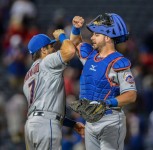
While the Mets have issues regarding their ability to extend their starting pitching, they have other areas to address as well. As it stands, the Mets may have around $97 million off the books by 2019. The Mets will need that money not just to re-sign pitching, but also to build their roster.
One key decision the Mets will have to make is at catcher. By 2019, Travis d’Arnaud will be a year away from free agency. Kevin Plawecki will be in either his first or second arbitration year around the same time.
As it stands going into the 2016 season, the team is best suited to have d’Arnaud starting with Plawecki as his backup. However, I do question if that arrangement is the best situation for the long term. It can be argued with the Mets going into this season with that arrangement, they risk the diminution of the trade value of either or both of these players. It’s a tough decision to make.
Travis d’Arnaud
d’Arnaud is a 27 year old catcher, who is presumably entering the prime of his career. He will be 31 when he becomes a free agent, assuming the Mets don’t work out an extension with him before that.
After working out his game in AAA in 2014, he seems to have fulfilled his offensive potential. When he returned, he hit .272/.319/.486 with 10 homers and 32 RBI in 69 games. He had a low BABIP of .287, which showed these numbers could get even better. They did in 2015. He hit .268/.340/.485 with 12 homeruns and 41 RBI in 67 games last year. He again had a low BABIP of .289. So there may still be room for improvement (assuming of course that the .287 – .289 BABIP is his natural level).
On top of these good and improving numbers, d’Arnaud has shown himself to be a good catcher. He was a highly rated pitch framer in 2014, and he was again in 2015. It’s important to get those extra strike calls to help reduce the pitches thrown by your pitching staff. In fact, d’Arnaud was the best at it last year. Despite his troubles in the World Series, d’Arnaud had an acceptable 32.6% rate of throwing out would be basestealers.
I understand there is more to catching than this, however the other things involved like blocking pitches in the dirt aren’t as quantifiable. Regardless, the most important thing for a catcher is to be a good receiver, and d’Arnaud has seemingly and statistically fine very well in that area.
Between d’Arnaud’s offensive and defensive abilities, you’d be hard pressed to find a reason not to extend d’Arnaud.
Unfortunately, there is a reason. Whether it’s fair or not, d’Arnaud is getting a reputation as injury prone. Last year, d’Arnaud had two freak contact injuries. In April, he broke his pinkie when he was hit by a pitch. When he returned from the DL, he suffered a hyper-extended elbow on a tag play. If that was it, I presume most teams would chalk it up to the freak nature of those injuries. However, he also had a number of injuries in the minors.
This year will be a big year for d’Arnaud. If he stays healthy, he’s primed for a big year; the type of year that will get him paid well in arbitration and free agency. If he gets injured again, he gives validity to the injury prone label thereby diminishing his arbitration and trade value.
Kevin Plawecki
Coming into the 2015 season, Plawecki was a well regarded prospect. Reflecting upon Plawecki’s 2015 season, it’s strange to think he was a highly regarded prospect more because of his bat than his glove.
Like d’Arnaud, Plawecki was exceptional in pitch framing last year. In fact, among big league catchers last year, he was second best. He was not as adept as d’Arnaud in throwing out baserunners. He only threw out 25.6% of basestealers. Given his needing to work on his footwork behind the plate, this should not come as a surprise. Unfortunately, the Mets losing Bob Geren is a hindrance because Geren was well regarded in his ability to work with catchers. That’s not to say Plawecki can’t improve.
Offensively, Plawecki is a different hitter than d’Arnaud. Whereas d’Arnaud has been seen as a power threat, Plawecki is seen as a gap to gap hitter. His offensive game was thought to be so advanced it was thought he could challenge d’Arnaud for playing time last year. That never happened. In part, that is because Plawecki had a tough rookie year.
In an admittedly weak Mets lineup, Plawecki hit a woeful .219/.280/.296 in 73 games. One could be further pessimistic about Plawecki’s offensive potential by looking to his AAA numbers. In AAA, in a hitter’s league, Plawecki only hit .262/.318/.392 over parts of two seasons. However, that’s not the full picture of Plawecki offensively.
Keep in mind, Plawecki only played 65 games in AAA, which is not a full season. Over the course of his minor league career, Plawecki was a much more palatable .290/.364/.432 hitter. Furthermore, while Plawecki’s major league numbers were lackluster, he had a low .277 BABIP. This suggests he’s due for an improvement at the plate next year. Overall, given how well regarded a prospect he is, it would be fair to presume Plawecki could be much better offensively next year.
We also don’t know what, if any effect, Plawecki’s sinus problems had last year. Plawecki admitted he felt dizzy during parts of last season. With his offseason surgery, and a year in the majors under his belt, Plawecki could be due for a much improved 2016.
The main thing holding him back will be d’Arnaud. As d’Arnaud’s backup, Plawecki will get limited reps at the plate hindering his ability to improve. Furthermore, with reduced playing time, Plawecki’s numbers can swing drastically. He’s as likely to have good numbers as he is to have poor numbers. Whichever way it goes, it’s likely to be a small sample size. With that said, if he has another poor offensive season, whether it’s driven by a low BABIP or not, it will be hard to unring that bell.
Another issue is Plawecki’s status as the backup catcher. While it’s understandable the Mets want Plawecki around to play a little more to help keep d’Arnaud healthy, it should be noted that this still makes Plawecki a backup catcher. While his status as a backup catcher will drive down his arbitration numbers, it will also drive down the return you may get for him in a trade.
Why Are They Both on the Roster
Simply put, d’Arnaud and Plawecki are both on the roster because it gives the Mets the best chance to win in 2016. The hope is that Plawecki can catch more frequently than your average backup to keep d’Arnaud fresh and healthy.
In addition, the Mets are contemplating letting both learn other positions to keep them both fresh and get them both enough at bats. It’s more important for Plawecki because he’s still a young prospect who needs at bats. d’Arnaud could also benefit because getting him out from behind the plate should keep him fresh over the course of the year.
As such, the Mets will need both in the majors. If they play it right, they could get good years from both while maintaining or improving their trade value. This could be Terry Collins biggest challenge in 2016.
d’Arnaud’s Potential Contract
Given the expense that will be incurred in locking up the Mets starting pitching, who the Mets keep may be driven by how expensive they will be.
Naturally, d’Arnaud’s value will vary depending upon his health. If d’Arnaud is healthy, the comp I would use for his contract is Russell Martin. When Martin signed his most recent free agent deal with the Blue Jays, he was coming off a career year where he hit .290/.402/.430. With that’s said, Martin was a career .259/.364/.399 hitter, and he was coming off his age 31 season. That is how old d’Arnaud will be when he becomes a free agent.
Now, d’Arnaud has hit for more power than Martin. However, Martin is more durable, and he has been seen as a leader. Martin has averaged 129 games behind the plate. d’Arnaud has not caught more than 108 in a season. However, assuming d’Anaud is healthy, you would envision him being a catcher who is comparable to Russell Martin, if not better. Accepting that premise, here is the breakdown of Martin’s contract:
- 2015: $7 million
- 2016: $15 million
- 2017: $20 million
- 2018: $20 million
- 2019: $20 million
Now, I’m not suggesting the Mets would or should give d’Arnaud a five year $82 million contract. Martin was a free agent, who could’ve signed with anyone. d’Arnaud loses some bargaining power by being arbitration eligible. If the Mets sought to enter into a deal with him, buying out some free agent years, his contract could reasonably look like this:
- 2018: $8 million – $10 million
- 2019: $10 million – $15 million
- 2020: $15 million – $20 million
- 2021: $15 million – $20 million
Assuming this is a fair and reasonable range, the Mets available money, assuming no increase in the payroll, would be between $82 million to $87 million to complete the roster.
Plawecki’s Cost
While d’Arnaud may cost the Mets between $10 – $20 million, Plawecki should cost less. If Plawecki remains with the club for all of 2016, he will likely become a Super Two player (assuming no changes to the CBA). As such, Plawecki would become arbitration eligible in 2019.
Now, if the Mets were smart about tinkering Plawecki’s service time, they could delay his arbitration eligibility until 2020. That would mean in 2019, the Mets would only need to pay him approximately $500-$600 thousand leaving the bulk of the $97 million to pay their starters and fill out the roster.
With that said, if you’re going to keep Plawecki, and make him the starter, you’re going to have to pay him eventually. Judging by typical arbitration figures, Plawecki could earn anywhere from $1 million to $5 million depending on playing time and production. If Plawecki becomes the starting catcher, and he’s productive, he would be at the higher end of the spectrum.
Depending on the decision the Mets make on Plawecki, that $97 million figure could be reduced to the range of $92 – $96 million.
The Decision
Selecting between d’Arnaud and Plawecki is no easy task. While d’Arnaud is more polished offensively and defensively, he is also three years older, and he has a long injury history. He is going to be a lot more expensive than Plawecki at the time the Mets starting pitchers will become free agents.
On the other hand, Plawecki is a well regarded prospect that has yet to produce in AAA or the majors. There is still time for him to fulfill his potential. However, that will be difficult with the Mets keeping him on as a backup limiting his at bats. The best course would be for the Mets to put him in AAA, manipulate his service time, and let him improve. It appears the Mets won’t do that.
No matter what the Mets do, the time to make the decision between d’Arnaud and Plawecki is fast approaching. Sooner or later, the Mets will have to choose between the two. In terms of preserving trade value that decision could be in 2016 or 2017, at the latest. In terms of cost, it appears 2019 is the last date. It would behoove the Mets to make the decision sooner rather than later to maximize the return they would get for either player.
Overall, while he may be much more expensive, and therefore a possible hindrance to re-signing a starter, I would keep d’Arnaud. He’s already shown himself to be an offensive force while being a good receiver. He’s a better bet to produce going forward than Plawecki.
Hopefully, he’s healthy enough to justify an extension, and Plawecki improves enough to become a big trade chip. Ultimately, that is the best case scenario for the Mets going forward.
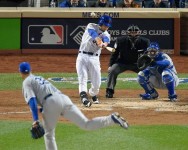
There are many out there calling the Mets offseason a success so far. Personally, I don’t see it. Yes, I know the offseason isn’t over, but we’re also pretty sure the Mets aren’t replacing Yoenis Cespedes‘ bat.
Overall, the Mets as constituted now are not better than the team that lost the World Series. Here was the lineup for the team that just lost the World Series, with their respective WAR from the 2015 season:
- Curtis Granderson 5.1
- David Wright 0.5
- Daniel Murphy 1.4
- Yoenis Cespedes 6.3
- Lucas Duda 3.0
- Travis d’Arnaud 1.7
- Michael Conforto 2.1
- Wilmer Flores 0.8
Combined 20.9
If the Mets make no other additions this offseason, which still remains a possibility, here’s the Mets 2016 starting lineup with the player’s WAR from last year.
- Curtis Granderson 5.1
- Neil Walker 2.4
- David Wright 0.5
- Lucas Duda 3.0
- Asdrubal Cabrera 1.7
- Michael Conforto 2.1
- Travis d’Arnaud 1.7
- Juan Lagares 0.6
Combined 17.1
On paper, barring any further additions the 2016 starting lineup is worse than the 2015 World Series team. This is despite how more “athletic” the Mets are in the middle infield. In response, the argument is the Mets are now deeper. Are they? Let’s compare the 2015 and 2016 benches.
Before comparing, it should be noted I’m going to use a traditional 13 position players and 12 pitchers split. That means I will have to eliminate once bench player from the 2015 Mets. I’m choosing to remove Kirk Nieuwenhuis from the roster as he was called up in September.
I’m also dropping Juan Uribe from the 2015 roster. When building a team, you’re going to want a backup shortstop. Uribe doesn’t fit the bill. Since Ruben Tejada was injured, and thus unavailable, I’m replacing him with Matt Reynolds, whom I’m assigning a 0.0 WAR since he didn’t play at all last year.
Here’s the modified 2015 World Series bench:
- Kevin Plawecki 0.9
- Matt Reynolds 0.0
- Michael Cuddyer 0.5
- Kelly Johnson 0.3
- Juan Lagares 0.6
Combined 2.3
Here’s the current bench, which would be subject to change with a free agent signing:
- Kevin Plawecki 0.9
- Wilmer Flores 0.8
- Ruben Tejada -0.1
- Kirk Nieuwenhuis 0.7
- Eric Campbell -0.5
Combined 1.8
Now to be fair, the 2016 bench will mostly likely not have Eric Campbell on the Opening Day roster. Eliminating his -0.5 would balance out these benches.
Here’s one big problem, if not Campbell then who? Let’s assume Mets fans get their way, and the team signs Denard Span. Span had a 0.7 WAR last year. Yes, that’s the same as Kirk’s. Slotting Span into the everyday lineup has this effect:
- Starting Lineup WAR increased from 17.1 to 17.2
- Bench WAR decreased from 1.8 to 1.7
- Eric Campbell or Kirk Nieuwenhuis is still on the Opening Day roster
Now, first counter-argument will be the offseason isn’t over, so the Mets can still make additional moves. Currently, without any other moves, the Mets payroll stands around $105.7 million. Let’s assume for arguments sake, the Mets have around $10 million to spend. With that $10 million, the Mets are looking to add a reliever, a CF, and another bat.
Span is estimated to receive about $12 million a year. Well, that blows the whole budget. Even assuming the Mets could get Span for less, they’re not going to have enough money for a reliever and another bat after that. So again, chances are either Campbell or Kirk will be in the Opening Day roster.
The next counter-argument is last year’s WAR doesn’t account for full years from Wright, d’Arnaud, or Conforto. This point-of-view is acceptable. However, you also have to acknowledge Granderson may be due for a regression at 35 years of age with a repaired torn ligament in this thumb. Also, based upon their histories, you can’t rely on Wright or d’Arnaud to last a full season. Essentially, while you can expect some players to improve or play more often, you can expect others to regress and/or suffer injuries.
Overall, the Mets still might be able to win the NL East and return to the playoffs in 2016. They will do so because of their pitching. However, objectively speaking, you have to admit the 2016 Mets are and will be weaker than the 2015 Mets team that lost the World Series.
That is unacceptable.
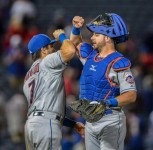
Growing up, watching those 80’s teams I remember going to a game or two when Gary Carter would get out from behind the plate and play on the field. It was a way to give him a day off while keeping his bat in the lineup.
I was thinking of that when I saw a report the Mets were not considering moving either Travis d’Arnaud or Kevin Plawecki out from behind the plate. Personally, I agree that they both help the Mets as catchers. d’Arnaud has hit well, especially for a catcher, while Plawecki has offensive potential. They are also excellent pitch framers. However, I still think it’s important d’Arnaud gets some work to let him play some games at third.
The Plawecki Reason
The first reason is Plawecki is still developing. You don’t want him languishing away on the bench as a backup for 162 game season.
Looking over the 2015 season, the catchers who caught most caught between 112 – 139 games this year. The average amount of games caught between them is about 125 games a season. This leaves Plawecki with only 37 games. If you could find another spot for d’Arnaud once a week, you could have Plawecki catch about two times per week. There’s 26 weeks in the MLB season. If Plawecki can play two games per well, that’ll get him an additional 15 games
It’s still not enough for a developing player, but it’s a lot better.
Injury Factor
d’Arnaud has been named the Mets 2014 and 2015 Opening Day catcher. He didn’t make it through either season without a trip to the DL.
In 2015, they were fluke injuries that landed him on the DL. One injury was a broken pinkie on a hit by pitch. The other was a strained elbow on a play at the plate. I don’t believe d’Arnaud is injury prone. However, it’s getting harder and harder to say that.
Truth is last year he had two separate DL stints costing him around 50 games. With a dismal Mets offense, they had to turn to Plawecki, especially with Anthony Recker and Johnny Monell doing nothing offensively. It’s that reason the Mets will use Plawecki as the backup next year. You don’t want to stunt Plawecki’s development, but d’Arnaud has a bat you don’t want to take out if the lineup.
The best solution is to allow d’Arnaud to play some games at another position to get him some at bats while letting him rest a bit by bit being behind the plate.
The David Wright Factor
Ultimately, I think the reason you let d’Arnaud play some third is because of David Wright. He can’t play more than four games in a row. Assuming he has to take off a game at least once a week, that’s 26 games. He still may need more than that as he re-adjusts to playing over 162 games.
When he returned, he had similar numbers to his whole career. Last year, he hit .289/.379/.434 (yes that includes the right games he played in April). For his career, he has hit .298/.377/.493. Sure, there’s less power, but he’s still a good hitter. It’s a bat they’ll miss when he’s not in the lineup. Right now, it seems the Mets have interest in bringing back Kelly Johnson as a utility player. Presumably, he will play the majority of games Wright doesn’t play.
Johnson is a career .251/.331/.424 hitter. Last year, he hit .250/.304/.414. d’Arnaud hit .268/.340/.485 last year. He’s a better hitter than Johnson. If you’re concerned about defense, Johnson isn’t exactly a Gold Glover. He’s average. There’s no reason d’Arnaud can’t be average out there with some work.
Overall
I think it would help d’Arnaud to stay healthy to get out from behind the plate. It would help Plawecki’s development to get some extra reps out there. It would help the Mets offense to have d’Arnaud’s bat out there when Wright can’t play. This move will help the Mets in 2016 and beyond.

Remember when #PanicCity was a thing? I do too. It was justified then. When Sandy Alderson bestowed the moniker on Mets fans, here was the previous night’s starting lineup:
- Curtis Granderson
- Ruben Tejada
- Lucas Duda
- Michael Cuddyer
- Wilmer Flores
- Darrell Ceciliani
- Kevin Plawecki
- Jacob deGrom
- Dilson Herrera
Look at that lineup. The number two and five hitters rotate in the eighth spot, at least until Tejada went down. The number three hitter bats fifth. The cleanup hitter is on the bench. The seventh hitter is a backup. The sixth and ninth hitters are not on the playoff roster.
This is a different team than that one. This team was one out away from winning Game One. They had a bad game against an erratic pitcher, who has pitched well against the Mets in the past. Why must it be more than that?
We just watched our young pitchers now down an incredible Cubs offense. We know good pitching beats good hitting. It’s the reason the Mets are in the World Series. This isn’t the same old Mets offense. They can actually hit now.
The Mets are getting a needed day off to collect themselves. They’re going to set things straight. They’re going out tomorrow, and they’re going to play their best game of the year. Then they’ll go out in Game 4 and do the same thing, and so on and so on.
Ya Gotta Believe!
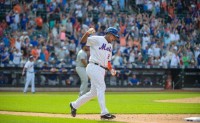
He’s worked hard to get to this point, and the Mets have rewarded the work by adding Juan Uribe to the World Series roster:
Juan Uribe is on the #Mets World Series roster. Matt Reynolds is off.
— Steve Gelbs (@SteveGelbs) October 27, 2015
The Case for Uribe
This team turned around with the Uribe trade. He’s been on World Series winners in 2005 and 2010. You’re hoping for a little five year luck there.
Unlike most teams, the Royals have two lefties in the pen with Danny Duffy and Franklin Morales. Adding Uribe gives the Mets an extra right handed bat off the bench. After Michael Cuddyer the Mets can turn to Uribe. This allows Juan Lagares to be a defensive replacement, and Kevin Plawecki to be ready for a Travis d’Arnaud injury. Don’t worry I tapped on every piece of wood within the nearest square mile after typing that.
Additionally, it lengthens the bench. In a way, it’s amazing the Mets playing with a 24 man roster never caught up with them. In actuality, there was no way Matt Reynolds was going to play. At least now, the Mets don’t have a dead roster spot.
I have to say it’s a pretty convincing case. I still don’t like the move.
The Case Against Uribe
The last time the Mets thought Uribe could go, he exacerbated his chest injury. If that happens in the World Series, the Mets will be burning through 3-4 players in one at bat (original player, Uribe, new batter, defensive replacement). If this happens in Citi Field, this team is in real trouble.
The next reason is your backup SS is now Kelly Johnson. He’s only played one game at SS, and that was this year. He’s the DH in Game One. If anything happens to Wilmer Flores, the Mets have a terrible choice to make. Do you lose the DH? Do you move David Wright and his back there? Do you put Uribe there? Or my personal favorite:
Is everyone forgetting they can put Jacob deGrom at SS in a pinch?
— Joe DeMayo (@PSLToFlushing) October 27, 2015
Yes, the Mets can put Reynolds on the roster for the injured player, but that’s only AFTER the game. If anything happens to Flores, you’re playing a game without a SS [insert Flores isn’t a SS jokes here]. How quickly the Mets have forgotten that Flores almost had to leave Game 4 of the NLCS after hitting his head.
Furthermore, you’re risking a lot for someone who’s not a terrific hitter. In his playoff career, he has hit .204/.241/.338. As a Met, he has hit .219/.301/.430. As a pinch hitter this year, he has hit .190/.320/.333. He’s 0-4 this year as a DH. It’s just too much to risk for someone that really only plays third and just doesn’t hit the way you think he does.
Yes, he can change a game and a series with one swing of the bat. It still doesn’t change the fact that this move is extremely risky. I hope he does not only because he’s a Mets fan, but also he’s a big part of this team.